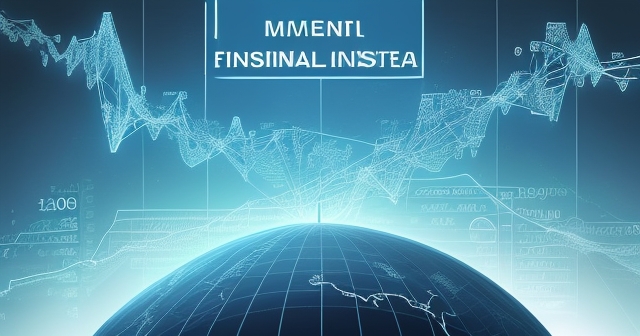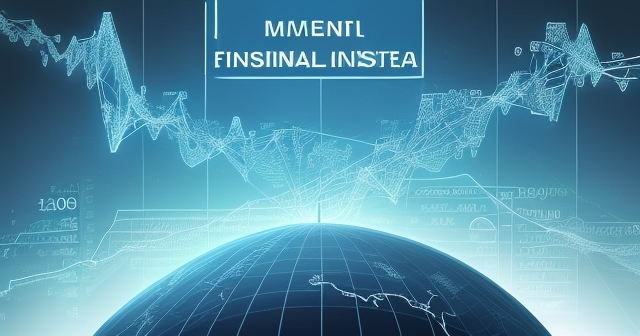Navigating Elevated Risks: Understanding Global Financial Instability in Today’s Economy
Recent global events, from persistent geopolitical tensions and shifting trade dynamics to episodes of acute financial stress like the failures of Silicon Valley Bank and Credit Suisse, have starkly underscored the ever-present threat of financial instability. Major institutions like the International Monetary Fund (IMF) and central banks worldwide have sounded alarms, warning that the risks to global financial stability have significantly increased. As investors and traders navigating these complex waters, understanding what financial instability truly means, what drives it, where vulnerabilities lie, and how authorities attempt to mitigate its impact is not just academic – it’s essential for informed decision-making and safeguarding your financial future.
Think of the financial system as the intricate circulatory system of the economy. It channels funds from savers to borrowers, enables payments, and allows for risk management. When this system functions smoothly, it supports growth, innovation, and prosperity. But when it becomes unstable, it can seize up, leading to a severe disruption in the flow of credit and capital, with potentially devastating consequences for businesses and individuals alike. Our goal here is to peel back the layers and understand this critical concept together.

A financially stable system reliably performs key functions: it facilitates the allocation of savings to productive investments (credit intermediation), allows for efficient payments for goods and services, and helps manage financial risks. Instability, conversely, occurs when a shock, internal or external, severely impairs this credit intermediation process. When credit dries up, businesses can’t fund operations or expansion, individuals struggle to borrow, and economic activity slows dramatically. This severe disruption in lending is often referred to as a credit crunch, and its effects can cascade through the economy, leading to reduced production, increased unemployment, and general hardship.
Consider the global financial crisis of 2008. While it began with specific issues in the housing market and related securities, it quickly spread through the interconnected financial system, causing major banks to fail or require bailouts. The resulting freezing of credit markets had profound impacts on the real economy worldwide. That’s a textbook example of what happens when financial instability takes hold and isn’t contained effectively.
Importantly, ensuring financial stability isn’t about predicting the next crisis event with perfect accuracy. Instead, it’s primarily about identifying, monitoring, and assessing inherent vulnerabilities within the financial system and working to build sufficient resilience to withstand potential shocks, whatever their origin. It’s like reinforcing a building against earthquakes – you can’t predict exactly when or where the next one will hit, but you can build structures strong enough to survive a significant tremor.
What is Financial Instability? Defining the Core Concept
Let’s start with a foundational question: What exactly do we mean by financial instability? It’s more than just market volatility or the occasional bank losing money. At its heart, financial instability refers to a state where problems within the financial system – be they in markets, institutions, or infrastructure – are severe enough to threaten the system’s ability to perform its crucial functions. As the IMF defines it, it’s a condition where a shock could trigger problems that authorities would likely need to address through intervention to prevent widespread damage.
Let’s consider the broader implications of financial stability:
- Financial stability fosters sustained economic growth.
- It promotes confidence among investors and consumers.
- Stable financial systems mitigate the risks of banking crises.
A financially stable system reliably performs key functions: it facilitates the allocation of savings to productive investments (credit intermediation), allows for efficient payments for goods and services, and helps manage financial risks. Instability, conversely, occurs when a shock, internal or external, severely impairs this credit intermediation process. When credit dries up, businesses can’t fund operations or expansion, individuals struggle to borrow, and economic activity slows dramatically. This severe disruption in lending is often referred to as a credit crunch, and its effects can cascade through the economy, leading to reduced production, increased unemployment, and general hardship.

Consider the global financial crisis of 2008. While it began with specific issues in the housing market and related securities, it quickly spread through the interconnected financial system, causing major banks to fail or require bailouts. The resulting freezing of credit markets had profound impacts on the real economy worldwide. That’s a textbook example of what happens when financial instability takes hold and isn’t contained effectively.
Importantly, ensuring financial stability isn’t about predicting the next crisis event with perfect accuracy. Instead, it’s primarily about identifying, monitoring, and assessing inherent vulnerabilities within the financial system and working to build sufficient resilience to withstand potential shocks, whatever their origin. It’s like reinforcing a building against earthquakes – you can’t predict exactly when or where the next one will hit, but you can build structures strong enough to survive a significant tremor.
Drivers of Current Financial Stability Risks
Why are institutions like the IMF currently highlighting increased risks? A confluence of factors has created a challenging environment. Let’s explore the primary drivers cited by global financial guardians.
| Driver | Description |
|---|---|
| Economic Uncertainty | Shift from low-interest rates to higher borrowing costs increases stress for borrowers. |
| Tighter Financial Conditions | Higher interest rates and less liquidity increase borrowing costs for businesses. |
| Geopolitical Risk | Conflicts and trade disputes affect financial market stability and predictability. |
One major contributor is heightened economic uncertainty. After a period of unprecedented monetary stimulus, central banks worldwide have rapidly tightened financial conditions to combat inflation. This shift from near-zero interest rates to significantly higher borrowing costs creates stress points. Businesses and individuals who borrowed heavily during the low-rate era face higher debt service costs. Asset values that were inflated by easy money may face corrections. This economic transition is inherently uncertain, making forecasting and risk management more difficult for financial institutions and investors.
Tighter global financial conditions themselves are a direct driver of risk. Higher interest rates and reduced central bank liquidity make it more expensive and harder for some entities to borrow. This can expose weaknesses in over-leveraged businesses or financial firms, increasing the probability of defaults or funding squeezes. The rapid pace of this tightening, compared to historical cycles, adds to the challenge, leaving less time for the system to adjust gradually.
Beyond purely economic factors, geopolitical risk has risen significantly on the list of concerns. Conflicts, trade disputes, and shifting international relations can directly impact financial markets. They can trigger sudden spikes in commodity prices, disrupt supply chains, increase volatility in asset prices, and raise borrowing costs for governments and corporations perceived as being in risky regions or sectors. For example, trade policy uncertainty, such as the imposition of tariffs, can disrupt long-standing trade finance arrangements, requiring banks to hold more capital against potentially higher risks of non-payment. These events are often unpredictable in their timing and specific impact, making the system more susceptible to sudden shocks.
These broad drivers — economic uncertainty, tighter financial conditions, and geopolitical factors — create a backdrop against which existing vulnerabilities within the financial system are more likely to be exposed and amplified. Understanding these specific weak points is crucial.
Identifying Key Vulnerabilities Within the System
While the global financial system has become more resilient since the 2008 crisis thanks to regulatory reforms, significant vulnerabilities persist and new ones emerge. The IMF and other bodies have identified three key areas of concern that could pose significant risks in the current environment.
High Valuations in Certain Markets
Despite recent market corrections, some segments of asset and corporate debt markets may still exhibit high valuations relative to historical norms or underlying economic fundamentals. When asset prices are inflated, they are more susceptible to sharp declines if sentiment shifts or economic conditions deteriorate. This is particularly true in areas where investors may have taken on excessive risk in the search for yield during the low-interest-rate period. A significant correction in these markets could impact the balance sheets of financial institutions and investors holding these assets, potentially leading to losses and reduced lending capacity.

Risks from Highly Leveraged Non-Bank Financial Institutions (NBFIs)
Perhaps one of the most significant areas of growing concern is the complex world of non-bank financial institutions (NBFIs). This diverse sector includes entities like hedge funds, money market mutual funds (MMMFs), private equity funds, insurance companies, and more. Over the past decade, NBFIs have grown substantially and now perform many functions traditionally associated with banks, such as credit provision and liquidity transformation (offering investors easy access to funds while holding less liquid assets).
While NBFIs provide valuable services, their growth and increasing interconnectedness with banks create new risks. Many NBFIs, particularly hedge funds, employ significant leverage, meaning they borrow heavily to amplify potential returns. While leverage can boost gains, it also magnifies losses. If leveraged NBFIs face losses or funding pressures (for instance, if lenders demand collateral or call back loans), they may be forced to sell assets rapidly. This could depress market prices, causing losses for other market participants, including banks, and potentially triggering a downward spiral – a classic example of contagion.
Furthermore, NBFIs like MMMFs and stablecoins are vulnerable to runs, similar to bank runs but occurring in financial markets. If investors suddenly lose confidence in the value or liquidity of an NBFI’s assets, they may rush to redeem their investments, forcing the NBFI to sell assets quickly, potentially at fire-sale prices. This can amplify strains in funding markets, impacting not only other NBFIs but also banks that rely on these markets for short-term funding or have exposures to NBFIs. The increasing interconnectedness between banks and NBFIs is a key focus area for regulators seeking to understand and mitigate systemic risk.
Sovereign Debt Challenges
A third major vulnerability lies in sovereign debt markets, particularly for highly indebted countries. Years of low-interest rates allowed many governments to accumulate significant debt burdens. As interest rates rise, the cost of servicing this debt increases. For countries with large debt loads or limited fiscal space, this can become unsustainable, raising the risk of default or debt restructuring.
| Challenge | Impact |
|---|---|
| High Debt Loads | Can lead to default or debt restructuring. |
| Rising Interest Rates | Increase the cost of servicing debt. |
| Impact on Financial Institutions | Decline in government bond values can impair balance sheets. |
Problems in sovereign debt markets can have widespread financial stability implications. Banks and other financial institutions hold government bonds, and a decline in the value of these holdings can impair their balance sheets. Sovereign stress can also trigger capital flight, currency depreciation, and economic instability within the affected country, with potential spillovers to other nations through trade and financial channels. Emerging Market and Developing Economies (EMDEs) are often particularly vulnerable to these dynamics, especially when faced with higher USD funding costs and capital outflows.
These three vulnerabilities – high valuations, leveraged NBFIs, and sovereign debt risks – are not isolated. They can interact and amplify each other, creating complex pathways for stress to spread through the system. For example, a sharp correction in asset markets could trigger funding pressures for leveraged NBFIs holding those assets, forcing sales that further depress prices and potentially stress banks with exposures to both the assets and the NBFIs.
Lessons from Recent Stress Events (2022-2023)
The period from late 2022 into early 2023 provided sharp reminders that vulnerabilities can materialize into acute stress events, even within seemingly solid parts of the financial system. The failures of Silicon Valley Bank (SVB) and Signature Bank in the United States, and the emergency resolution of Credit Suisse in Switzerland, offered critical lessons.

The cases of SVB and Signature Bank highlighted the speed at which problems can escalate in the digital age. While specific issues related to their balance sheet management (holding large unrealized losses on government bonds due to rising rates) were central, the immediate cause of their failure was a rapid bank run, facilitated by the speed of electronic transfers and social media communication. Depositors, many of whom were large, uninsured businesses, withdrew billions in hours. This overwhelmed the banks’ liquidity, forcing regulators to step in.
The official response demonstrated the imperative for swift action to prevent contagion. In the US, authorities invoked the Systemic Risk Exception, allowing the Federal Deposit Insurance Corporation (FDIC) to protect all depositors (insured and uninsured) at SVB and Signature Bank, preventing potential panic at other regional banks. The Federal Reserve also established the Bank Term Funding Program (BTFP), an emergency lending facility offering banks liquidity against collateral valued at par, helping to alleviate immediate funding pressures across the system.
Across the Atlantic, Credit Suisse, a globally systemic bank, faced a loss of confidence following years of scandals and financial underperformance. While its issues were long-standing, the stress in the US regional banking sector contributed to the loss of market trust. Swiss authorities orchestrated an emergency takeover by rival UBS, coupled with significant government backstops and central bank liquidity provision. This involved unprecedented steps, including the controversial write-down of Credit Suisse’s Additional Tier 1 (AT1) bonds, which were structured to absorb losses before equity in a resolution scenario, but were wiped out ahead of shareholders in this specific intervention.
These events provided several key takeaways:
- Speed of Contagion: Problems can spread extremely rapidly in today’s interconnected, digitally-enabled financial system.
- Importance of Liquidity: Even seemingly solvent institutions can fail due to a sudden loss of liquidity from depositor or market runs.
- Effectiveness of Backstops: Government guarantees (like deposit protection) and central bank emergency lending are powerful tools for stopping panic.
- Limits of Standard Resolution: While frameworks like the FSB’s Key Attributes for Effective Resolution Regimes and the EU’s Bank Recovery and Resolution Directive (BRRD) exist to manage failing banks in an orderly way, severe crises may require extraordinary, tailored interventions by governments and central banks, potentially involving fiscal resources. The Credit Suisse case demonstrated the complexities and difficult trade-offs involved in resolving a large, complex global bank.
- Supervisory Blind Spots: The SVB failure highlighted weaknesses in supervision regarding interest rate risk management and the composition of a bank’s deposit base, particularly for institutions that had grown rapidly.
- Role of Non-Banks: While SVB and Credit Suisse were banks, the stress events reinforced concerns about the stability and interconnectedness of NBFIs, which were also seeing some pressures in funding markets during this period.
These crises served as a stress test for the post-2008 regulatory framework and underscored the continuous need for vigilance and adaptation.
The Regulatory and Supervisory Response Imperative
The lessons from recent stress events, coupled with the persistent underlying drivers of risk, have reinforced the urgency for regulatory and supervisory action. What steps are authorities taking, and what more is being called for?
A fundamental call from international bodies like the IMF and the Financial Stability Board (FSB) is the full and consistent implementation of agreed-upon global standards, most notably Basel III. This framework aims to make banks more resilient by requiring them to hold more capital against potential losses and maintain sufficient liquidity buffers. While progress has been made, full implementation remains incomplete in some jurisdictions, particularly regarding the final elements often referred to as “Basel IV”. Regulators emphasize that higher capital and liquidity requirements are crucial defenses against unforeseen shocks.
Beyond the rules themselves, there is a strong push for enhanced and more intensive supervision of financial institutions. This means regulators need to be proactive in identifying risks *within* banks, such as vulnerabilities arising from interest rate exposures, concentration risks, or weaknesses in internal controls. It also means challenging management assumptions and business models and being prepared to intervene early when problems are identified. The SVB case, where supervisors reportedly identified issues but interventions weren’t sufficient to prevent failure, underscores the need for both clear rules and decisive supervisory action.
Increasing the oversight and understanding of non-bank financial institutions (NBFIs) is another critical area. Given their growing size, leverage, and interconnectedness, NBFIs are increasingly seen as a potential source of systemic risk. Regulators are working to improve data collection and analysis on NBFIs to better understand their activities, leverage levels, and linkages to banks and markets. Discussions are ongoing regarding potential regulatory measures for certain types of NBFIs that perform bank-like functions, such as money market funds and stablecoins, to address their vulnerability to runs and their potential to amplify market stress. The aim is not necessarily to regulate NBFIs exactly like banks, but to address specific systemic risks they may pose.
Strengthening the interconnectedness analysis between banks and NBFIs is also vital. Understanding how stress in one sector can spill over to the other requires complex mapping and monitoring. Regulators are developing tools and frameworks to better assess these cross-sectoral risks.
Furthermore, recent events have prompted a re-examination of specific regulations, particularly for large banks. In the US, for instance, the Federal Reserve is undertaking a “Holistic Capital Review” to evaluate whether capital requirements for large banks need to be increased based on lessons from the recent stress. There are also discussions about tailoring regulations less based on a bank’s size threshold and more on its specific risk profile and systemic importance.
Finally, effective crisis management requires having clear resolution frameworks and sufficient resources in place *before* a crisis hits. While progress has been made in this area since 2008, the need for effective government backstop arrangements and reliable funding sources for resolution (in cases where a bank’s own resources are insufficient) was highlighted by the Credit Suisse and US bank failures. Authorities need the flexibility and capacity to provide liquidity and, in some cases, fiscal support to manage severe systemic events while also ensuring moral hazard is minimized over the long term.

Building Resilience Against Future Shocks
Given the persistent risks and the potential for unforeseen shocks, building and maintaining resilience is paramount for the financial system. This isn’t solely the responsibility of regulators; financial institutions themselves, market participants, and even individual investors play a role.
For financial institutions, resilience means having robust balance sheets with sufficient capital buffers to absorb unexpected losses and ample liquidity to meet funding needs even under stress. It also means having strong risk management frameworks that can identify and manage a wide range of potential threats, including operational risks, cyber risks, and risks arising from new technologies or business models.
For market participants, vigilance and sound risk practices are key. This includes conducting thorough due diligence on investments, managing leverage prudently, and understanding the potential for sudden shifts in market sentiment or liquidity conditions. As investors, being aware of the broader financial stability landscape helps you contextualize market movements and make more informed decisions about portfolio construction and risk tolerance.
At the sovereign level, governments play a critical role in maintaining fiscal space – the capacity to increase spending or reduce taxes without jeopardizing debt sustainability. Having fiscal space provides a buffer against economic downturns or financial crises, allowing governments to support the economy or the financial system if needed. Maintaining adequate international reserves also helps countries, particularly EMDEs, cushion against external financial shocks, such as sudden capital outflows or currency pressures.
Finally, effective international cooperation is essential. Given the interconnectedness of the global financial system, stress in one country can quickly spread elsewhere. International bodies like the FSB, IMF, and G20 play vital roles in coordinating regulatory reforms, conducting multilateral surveillance of risks, and facilitating cooperation in crisis management. Sharing information, harmonizing approaches where appropriate, and maintaining open lines of communication between national authorities are crucial for managing cross-border risks and responding effectively to global crises.
The principles articulated by thinkers like Walter Bagehot regarding central banks lending freely against good collateral in a panic, and the strategies employed by crisis managers like Timothy Geithner during the 2008 crisis (emphasizing speed, scale, and comprehensiveness), remain relevant. However, each crisis presents unique features, requiring adaptability and sometimes novel solutions, as seen with the tailored responses to SVB and Credit Suisse. The focus on pre-crisis preparation – building resilience, strengthening supervision, and enhancing resolution tools – is perhaps the most crucial lesson of all.
Addressing Specific Risk Areas: Trade Finance and Geopolitics
Let’s briefly delve deeper into a couple of specific areas mentioned earlier that contribute to financial instability risks: trade finance and the evolving impact of geopolitical events.
Trade finance is the backbone of global commerce, providing the credit, guarantees, and insurance needed to facilitate cross-border transactions. Banks are major providers of trade finance. Changes in trade policies, such as the imposition of tariffs or sanctions, can increase the perceived risk of trade transactions. This might lead banks to reduce their trade finance exposure or require more capital against potential losses on these assets. A significant disruption in the availability of trade finance, especially for certain regions or specific goods, could act as a brake on international trade, potentially impacting global economic activity and, by extension, financial stability.
The impact of geopolitical risks on financial stability is multifaceted and increasingly prominent. These risks can manifest in various ways:
- Market Volatility: Geopolitical events often trigger immediate spikes in volatility across equity, bond, and currency markets as investors react to uncertainty.
- Asset Price Impacts: Conflicts or political tensions can directly affect the value of assets related to specific regions or industries (e.g., energy prices, defense stocks).
- Sovereign Risk Premiums: Geopolitical instability can increase the perceived risk of investing in a country’s government debt, leading to higher borrowing costs (risk premiums), particularly for EMDEs already facing debt sustainability challenges.
- Sanctions and Financial Sanctions: The use of financial sanctions as a geopolitical tool directly impacts financial institutions by requiring them to freeze assets, block transactions, and navigate complex compliance landscapes. Errors in compliance can lead to significant penalties, while navigating the rules itself requires substantial resources.
- Disruption to Cross-Border Flows: Geopolitical events can disrupt capital flows, payment systems, and access to critical financial infrastructure.
Financial institutions need to dedicate significant resources to identifying, quantifying, and managing geopolitical risks. This involves scenario analysis, stress testing, and building contingency plans for various potential outcomes. Supervisors are also increasingly scrutinizing how financial institutions are assessing and managing these complex, non-traditional risks.
Conclusion: Vigilance and Resilience in a Dynamic Landscape
The landscape of global finance remains dynamic and subject to shocks, but the goal of ensuring financial stability is constant. While regulatory frameworks and crisis tools have evolved significantly since the 2008 crisis, recent events demonstrate that vulnerabilities persist and new ones emerge, particularly outside the traditional banking sector in the burgeoning world of NBFIs. The interplay between macroeconomic shifts, geopolitical events, and these inherent structural vulnerabilities creates a complex challenge for policymakers, institutions, and investors alike.
Continued vigilance in identifying risks, coupled with a readiness for decisive, well-coordinated policy action and robust international cooperation, remains essential to maintaining the resilience of the financial system against future instances of instability. For you, as an investor or trader, understanding these dynamics isn’t just theoretical knowledge; it’s practical wisdom that helps you navigate market volatility, assess the broader economic backdrop, and make more resilient investment decisions. The path forward requires continuous learning, adaptation, and a commitment to building strong financial foundations, both individually and systemically.
financial instability meaningFAQ
Q:What leads to financial instability?
A:Financial instability can arise from factors such as economic uncertainty, high leverage in financial institutions, and geopolitical risks.
Q:How do central banks respond to financial instability?
A:Central banks may implement measures like changing interest rates, providing liquidity to banks, or even enacting emergency lending programs.
Q:What role do non-bank financial institutions play in financial stability?
A:Non-bank financial institutions can contribute to systemic risk due to their interconnectedness with banks and reliance on leveraged financial strategies.
